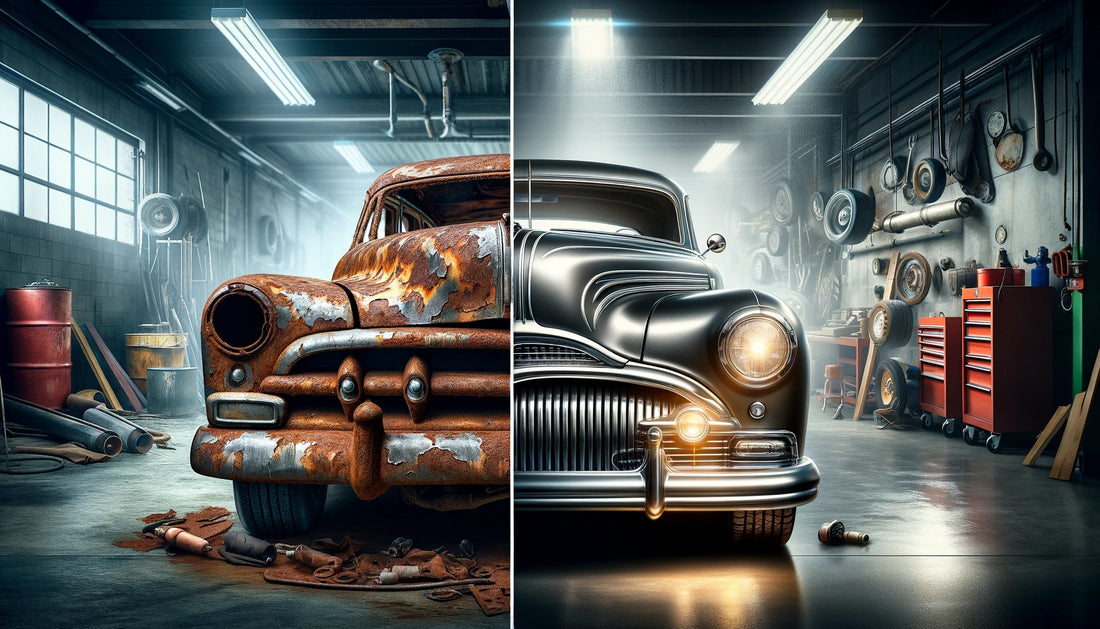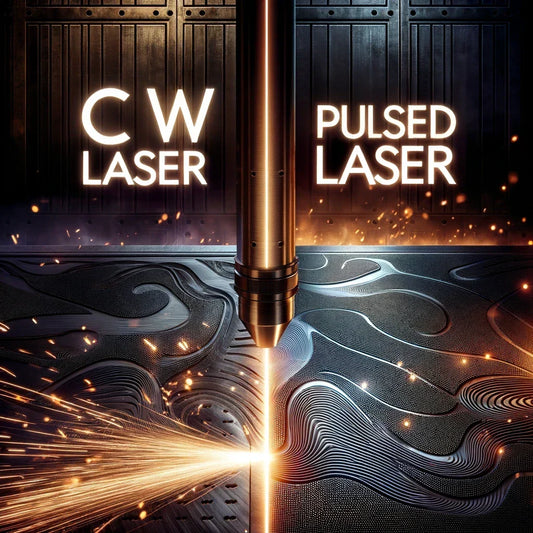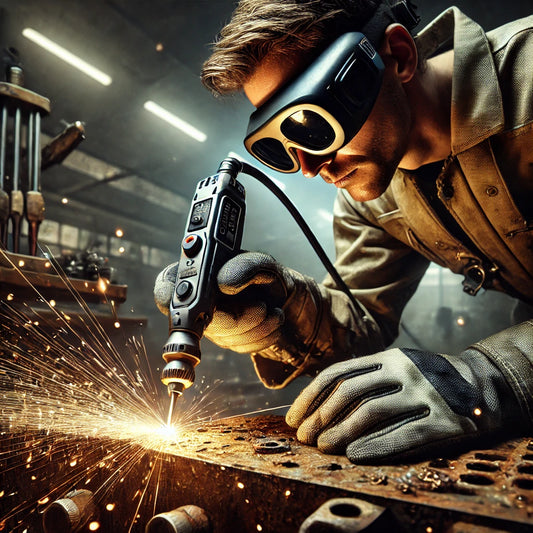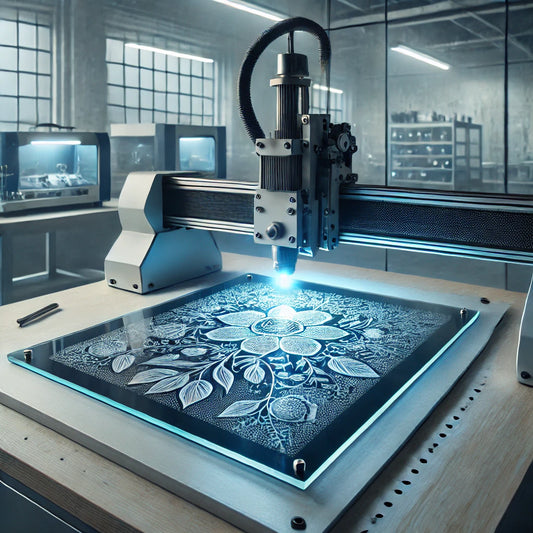
How Does Laser Rust Removal Work?

In the battle against corrosion, rust stands as a formidable adversary to metal components and structures, threatening their integrity and longevity. Traditionally, combating rust has involved a variety of methods, ranging from manual scrubbing with abrasives to chemical treatments, each with its own set of drawbacks and limitations. However, advancements in technology have paved the way for a more efficient, environmentally friendly, and effective solution: laser rust removal.
Laser rust removal represents a leap forward in maintenance and restoration techniques. Utilizing high-powered lasers, this method offers a non-contact, precise way to eliminate rust without damaging the underlying material. It's a game-changer for industries, conservators, and auto restorers alike, providing a cleaner, faster, and more sustainable approach to rust removal. This article will explore the workings of laser rust removal, its advantages and disadvantages, and its varied applications. Whether you're a professional looking to invest in laser cleaning equipment or simply curious about this modern marvel, understanding laser rust removal can provide valuable insights into its potential to revolutionize maintenance and restoration efforts.
Understanding Rust Removal Process
Laser rust removal is a process that might seem straight out of a science fiction novel, yet it's grounded in sophisticated technology and physics. At its core, this method uses concentrated light beams—lasers—to target and disintegrate rust without harming the underlying metal. Here’s a closer look at how this innovative process unfolds:
The Science Behind the Laser
A laser rust removal device emits a focused beam of light at a specific wavelength, optimized to interact with the rust (oxidized metal) without affecting the metal beneath. When the laser beam hits the rusted surface, several key interactions occur:
- Absorption and Heat Generation: The rust particles absorb the laser energy, which converts into heat, causing the rust to rapidly heat up.
- Oxidation Layer Breakdown: The intense heat breaks down the oxidation layer—rust—into smaller particles or gasifies it. This reaction often leaves the original metal surface intact and unharmed.
- Ejection of Rust Particles: The rapid expansion and vaporization of rust create a pressure difference that ejects the rust particles away from the surface, effectively cleaning it.
Precise and Controlled
One of the remarkable aspects of laser rust removal is its precision. The laser can be finely controlled to target specific areas, allowing for detailed cleaning and preservation of historical artifacts or delicate parts where maintaining integrity is crucial. Additionally, the operator can adjust the laser's power, ensuring the removal process is as gentle or aggressive as needed based on the rust's severity and the metal's condition.
Efficiency and Cleanliness
Unlike abrasive methods that can leave residues or chemical treatments that involve hazardous substances, laser rust removal is clean and efficient. The process produces minimal waste, with the primary byproduct being small amounts of dust or gas from the vaporized rust, which can be easily extracted and filtered using standard industrial vacuum systems.
In summary, laser rust removal works by harnessing the power of light to precisely target and eliminate rust. This process not only preserves the underlying material but also offers a cleaner, more controlled, and environmentally friendly alternative to traditional rust removal methods. Its adoption across various industries highlights its effectiveness and potential to redefine how we maintain and restore metal surfaces.
Advantages of Laser Rust Removal
Laser rust removal technology, with its innovative approach to tackling corrosion, offers a multitude of advantages over traditional rust removal methods. These benefits make it an attractive option for a wide range of applications, from industrial maintenance to cultural heritage preservation.
Here are some of the key advantages:
Targeted Cleaning
The ability to precisely control the laser beam allows for selective removal of rust without affecting the underlying metal or surrounding areas. This precision is particularly valuable for restoring intricate designs or machinery with complex components.
No Chemicals Required
Unlike chemical treatments that involve hazardous materials, laser rust removal uses only light. This absence of chemicals not only makes the process safer for operators but also reduces environmental impact.
Minimal Waste Production
The process produces negligible waste, primarily dust and small particles from the vaporized rust, which can be easily collected and disposed of, further minimizing its environmental footprint.
Fast Cleaning Process
Laser cleaning is significantly faster than manual scrubbing or chemical soaking, especially for complex surfaces or heavily corroded materials. This efficiency can dramatically reduce downtime in industrial settings.
No Surface Damage
The non-contact nature of laser rust removal ensures there is no wear and tear on the metal surface, preserving the integrity of the original material and extending its lifespan.
Reduced Labor Costs
The automation potential of laser rust removal systems can lower labor costs associated with manual cleaning methods. The speed and efficiency of the process also mean that more work can be done in less time, further enhancing cost savings.
Lower Maintenance Costs
Laser systems, while requiring an initial investment, have relatively low maintenance costs compared to the ongoing expenses of chemical treatments or abrasive materials.
Reduced Risk of Injury
The automated and non-contact nature of the process minimizes the risk of injuries that can occur with manual rust removal techniques.
Wide Range of Applications
From automotive and aerospace to cultural heritage and sculpture, the versatility of laser rust removal makes it suitable for a diverse array of fields and materials.
Disadvantages of Laser Rust Removal
While laser rust removal boasts numerous advantages, making it a revolutionary method in material preservation and restoration, it's important to acknowledge its limitations and challenges. Understanding these disadvantages is crucial for individuals and businesses considering investing in laser rust removal technology. Here are some of the primary drawbacks:
High Equipment Cost
The initial cost of purchasing a laser rust removal system can be significant, making it a substantial investment for small businesses or individual users. The technology involves sophisticated components and precision engineering, contributing to its higher price point.
Training and Technical Expertise
Effective and safe operation of laser rust removal equipment requires specialized training. Operators must understand the nuances of laser settings and their effects on different materials to avoid damage to the items being cleaned.
Maintaining and troubleshooting laser equipment also demands a certain level of technical expertise, potentially requiring businesses to invest in additional training for their staff. However, some models of laser rust machines are very easy to operate, so the trainings are not required.
Material and Condition Limitations
While versatile, laser rust removal may not be equally effective on all types of materials or coatings. Certain metals or finishes can reflect the laser light, reducing efficiency or necessitating adjustments to the process. Read the products' technical descriptions to learn about the applicable materials for each laser model.
In cases of extreme corrosion where the material integrity is compromised, laser rust removal might not be suitable or might require preliminary treatment to ensure the laser can effectively remove the rust without damaging the material.
Energy Consumption
High-powered laser systems can consume a significant amount of electricity, especially when used for extensive periods. This increased energy usage can lead to higher operational costs and may impact the overall cost-effectiveness of the process for some businesses.
Despite these disadvantages, the decision to use laser rust removal should be informed by a thorough analysis of both its benefits and limitations. For many applications, the precision, efficiency, and environmental benefits of laser rust removal outweigh the initial costs and challenges. However, businesses and individuals must carefully consider their specific needs, material types, and financial constraints before investing in this technology.
Applications of Laser Rust Removal
The versatility of laser rust removal technology is showcased across various sectors, enhancing maintenance procedures, restoration projects, and preparation processes. Here's a deeper dive into its applications:
Industrial Manufacturing Equipment
Regular exposure to moisture or chemicals can lead to rust formation on production lines. Laser rust removal meticulously cleans these machines without disassembly, minimizing downtime and maintaining production quality. Read more about rust removal for industrial applications in our article.
Heavy Machinery Maintenance
In agriculture and construction, where equipment is frequently exposed to harsh environmental conditions, laser cleaning extends the lifespan of machinery, ensuring optimal performance and reducing the need for costly replacements.
Classic Car Restoration
Enthusiasts and professionals in the classic car community value laser rust removal for its ability to clean without altering the original metal, crucial for preserving the authenticity and historical integrity of vintage automobiles.
Body Shop Repairs
Collision repair shops utilize laser rust removal for efficient cleaning of damaged areas before body work, ensuring that repairs are performed on a pristine surface for better results and durability.
Shipyard Maintenance
The maritime industry benefits significantly from laser rust removal, particularly in shipyards where large vessels require frequent maintenance to combat the corrosive marine environment, enhancing both aesthetics and structural integrity.
Aviation Safety
In aerospace, the precision of laser rust removal is essential for addressing corrosion without compromising the critical tolerances of aircraft components, directly impacting safety and aircraft longevity.
Historical Preservation
The gentle yet effective nature of laser rust removal has revolutionized the preservation of metal artifacts, allowing conservators to remove centuries of corrosion without damaging the underlying material, a boon for museum curators and historians.
Monument Restoration
Public art and historical monuments, often subjected to pollution and weathering, are restored to their original glory, with laser technology ensuring that delicate details and inscriptions are preserved for future generations.
Urban Infrastructure
City infrastructure, including bridges and public buildings, benefits from laser rust removal in both aesthetic and structural terms, directly contributing to the safety and longevity of urban environments.
Utilities Maintenance
Water and power utilities employ laser cleaning to maintain and restore critical infrastructure, ensuring efficient operation and preventing failures due to corrosion.
Pre-Weld Surface Preparation
The cleanliness of metal surfaces prior to welding is paramount. Laser rust removal provides a contaminant-free surface, resulting in stronger, more reliable welds and reducing the risk of weld failures.
Coating and Finishing Prep
Before applying protective coatings or finishes, surfaces must be impeccably clean. Laser technology not only cleans but also slightly textures the metal surface, improving coating adhesion and longevity.
10 Factors to Consider When Choosing the Right Laser for Rust Removal
When selecting a laser system for rust removal, it's essential to consider various factors to ensure you choose the most effective and efficient option for your needs. Here are 10 critical factors to keep in mind:
- Power Output: Higher power allows for quicker rust removal but may increase costs and energy consumption. Assess the severity of rust you typically encounter to determine the necessary power level.
- Energy Efficiency: Opt for lasers that offer high energy efficiency to reduce operational costs. Efficient systems can provide significant savings over time.
- Type of Laser: Fiber lasers are commonly preferred for rust removal due to their efficiency and versatility. Evaluate if a fiber laser suits your needs or if another type might be more appropriate.
- Beam Quality: A high-quality beam can focus more energy into a smaller spot, enhancing rust removal precision and preventing damage to the underlying material.
- Adjustable Focus: Systems that allow for focus adjustments offer flexibility for different rust conditions and material thicknesses, making them more versatile.
- Material Compatibility: Confirm the laser system is effective on the materials you work with most frequently. Some lasers may be optimized for specific substrates.
- Work Environment Considerations: Take into account the physical size of the laser system and its portability, especially if space is limited or if the system will be used in multiple locations.
- Safety Features: Essential safety features include protective casings, emergency stops, and system malfunction alerts. Ensure the system comes with the necessary safety certifications. Also, learn what safety accessories can be added, for example, safety glasses.
- Warranty: A comprehensive warranty covering significant periods and major components can safeguard your investment and provide peace of mind. For example, all product at Lasers Only have 2 year product warranty.
- Technical Support: Consider manufacturers that provide strong after-sales support, including technical assistance and training, to ensure you can effectively use and maintain the laser system. Lasers Only is known for its excellent customer support. Our expert managers will help you during with the buying process and help you to find the best laser machine for your needs.
By carefully evaluating these 10 factors, you can make an informed decision when choosing a laser system for rust removal, ensuring it meets your specific requirements for performance, safety, and cost-efficiency.
In conclusion, laser rust removal stands as a transformative solution in the maintenance, restoration, and preservation sectors, offering a high degree of precision, efficiency, and environmental friendliness. As we've explored, selecting the right laser system involves careful consideration of various factors, including power output, beam quality, safety features, and material compatibility, among others. The right choice not only enhances the effectiveness of rust removal processes but also ensures the safety of operators and the longevity of the equipment.
The journey to integrating laser rust removal technology into your operations is an investment in the future—towards cleaner, faster, and more sustainable maintenance practices. Whether you're in the automotive, manufacturing, conservation, or any other industry plagued by corrosion challenges, the adoption of laser technology can significantly elevate the quality of your work and the efficiency of your operations.



